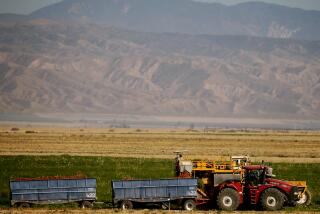Thirsty Towns’ Pumping Proposal Provokes Water Fight in Arizona
PRESCOTT, Ariz. — The battle lines in a festering water dispute in central Arizona’s burgeoning Yavapai County couldn’t be clearer.
A 7,700-foot mountain separates three thirsty communities looking for additional water and a cluster of smaller towns sitting above an expansive aquifer. It’s a physical barrier as imposing as the positions that divide the two sides.
The fight centers around a plan pushed by Prescott Mayor Sam Steiger, who wants to pump water from the Big Chino aquifer to ensure supplies for the cities west of Mingus Mountain.
Opponents on the east side argue the pumping could endanger the Verde River, which some believe is supplied by the aquifer. One of the last running rivers in Arizona, the Verde flows past acres of rich farmland in the Verde Valley and continues south toward Phoenix into Bartlett and Horseshoe lakes.
“It’s the heart of the Verde Valley,” said Chip Davis, chairman of the Yavapai County Board of Supervisors. “The river running through it is what makes the uniqueness of these cities and towns.”
Cottonwood, Camp Verde, Clarkdale and others in the Verde Valley have unanimously voted to stand against the plan to build a pipeline from the aquifer to serve Prescott, Prescott Valley and Chino Valley until it is determined how the river could be affected.
Prescott isn’t in danger of needing the water any time soon, but Yavapai County’s growth has boomed by 42% in the last 10 years, according to U.S. Census Bureau data. Faced with that kind of growth, Prescott needs to guarantee an adequate water supply for the future, Steiger said.
“If you wait until you need the water, it’s too late,” he said. “What we need to do is prepare. It’s obvious we’re going to continue to grow no matter how many of us manfully struggle against that.”
A 1980 state law allows Prescott to import up to 14,000 acre-feet of water annually from Big Chino. An acre-foot is 326,000 gallons, about enough to serve an average family of four for a year.
Prescott Valley and Chino Valley also would benefit from the pumping under an agreement that would have them pay to build the pipeline in exchange for access to the water.
Leaders of the Verde Valley cities are concerned about the possible consequences.
One U.S. Geological Survey report shows that about 80% of the Verde River’s headwaters originate from Big Chino aquifer.
“If you transport water away . . . it would probably affect the Verde River, and very quickly too,” said Winn Hjalmarson, a retired hydrologist who coauthored the report after more than 40 years of studying the river.
Those in favor of the pumping plan quickly dismissed the report, calling it biased.
“The simple truth is . . . that the only way you know at what level you can pump from the Big Chino without doing harm is to pump,” Steiger said.
At least one other study on the possible effects of pumping is underway, but it isn’t expected to be complete until 2004.
The timeline for when pumping will begin remains unclear.
Steiger was adamant that pumping would begin this year, while others involved say reaching various agreements, developing engineering plans and legal hurdles could tie up the plan for years.
That leaves those in the Verde Valley asking what’s the big hurry.
“Prescott alone is entitled to enough water to supply 135,000 people with water, and I think they have about 32,000,” said Tony Gioia, co-chairman of the Yavapai County Water Advisory Council. “There really is no reason for a rush here--they have a tremendous amount of water. They are well situated. It’s not like there is an urgent need for water.”
The debate also reaches beyond the confines of Yavapai County.
William Schrader, president of the Salt River Project, a Phoenix-area utility that has rights to Verde River water, recently sent a letter to the mayors of Prescott, Prescott Valley and Chino Valley citing the company’s “growing concern and opposition” to the plan.
“We’re not quite sure what Sam [Steiger] is up to, but we wanted to put Sam and the other mayors on notice that whatever it is, we’re concerned,” said Dave Roberts, the Salt River Project’s manager of water rights and contracts department.
The Verde River also is home to endangered aquatic species and is a significant source of water for downstream Indian tribes who claim rights to the river, the letter says. If pumping were to begin, Roberts said, the project would closely monitor the effects on the Verde and might take legal action to have it stopped.
Steiger argued that the project has no legal grounds for litigation and calls the threat a bluff. He said that despite widespread criticism, he has no intention of slowing down his plan.
“What we’re going to do--and we are going to do it--is determine at what level we can pump without doing harm to the river,” Steiger said. “And that’s not because we’re particularly virtuous people; it’s because that’s the law.”
*
Prescott Active Management Area: https://www.water.az.gov/azwaterinfo/InsideAMAs/amaprescott.html
U.S. Geological Survey report: https://greenwood.cr.usgs.gov/pub/open-file-reports/ofr-99-0378/
Salt River Project: https://www.srpnet.com
More to Read
Sign up for Essential California
The most important California stories and recommendations in your inbox every morning.
You may occasionally receive promotional content from the Los Angeles Times.










